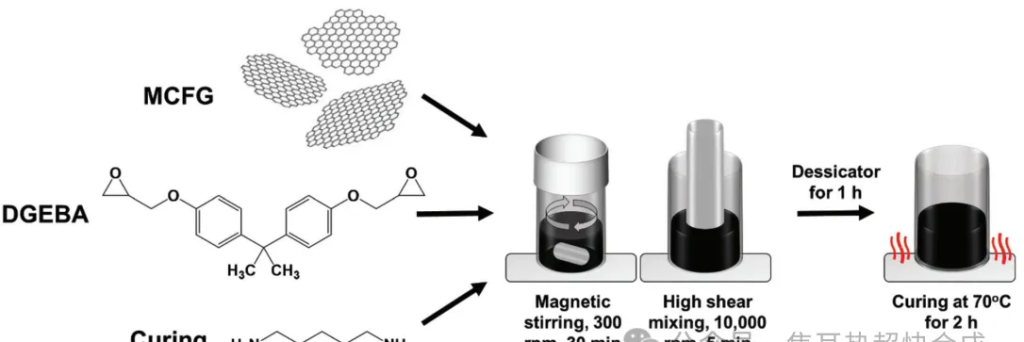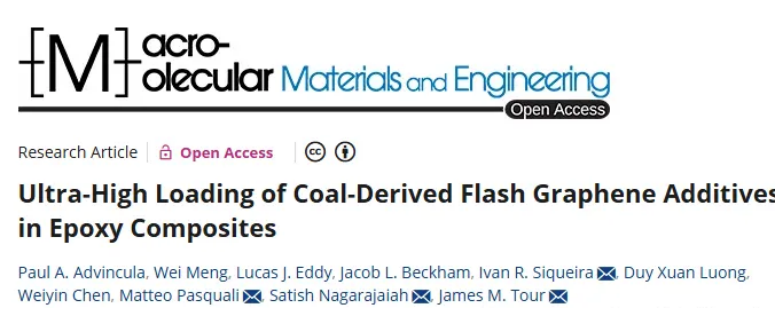Green Coal Upgrading: Flash Graphene Enhances Mechanical Performance of Epoxy Resin
1. Overview
In 2022, researchers James M. Tour, Satish Nagarajaiah, and Matteo Pasquali from Rice University published a study in Macromolecular Materials and Engineering titled “Ultra-High Loading of Coal-Derived Flash Graphene Additives in Epoxy Composites.” This research demonstrates how metallurgical coke can be transformed into high-quality flash graphene (MCFG) using flash Joule heating (FJH) technology. By incorporating high concentrations (20-50%) of MCFG into bisphenol-A epoxy resin (DGEBA), the team successfully developed graphene-epoxy composites with enhanced mechanical properties.
This novel approach not only improves the Young’s modulus, hardness, compressive strength, strain, and toughness of the composite but also reduces environmental impact by decreasing the amount of epoxy resin required during production. This breakthrough showcases the potential of graphene for large-scale industrial applications while offering a new green pathway for utilizing coal materials.
2. Research Background
Challenges in Traditional Graphene Production:
Graphene’s exceptional thermal, electrical, and mechanical properties make it highly sought after in composite materials. However, traditional production methods, such as mechanical exfoliation and chemical oxidation, are costly, limiting large-scale industrial adoption.
Flash Joule Heating (FJH) for Graphene Production:
The emerging FJH technology offers a low-cost alternative by transforming metallurgical coke (MC) into flash graphene (MCFG) rapidly and efficiently. This method significantly reduces production costs and energy consumption.
Objective of the Study:
The study aims to explore the feasibility of creating high-loading graphene-epoxy composites using MCFG and DGEBA epoxy resin, focusing on enhancing mechanical properties while lowering production costs and environmental impact.
3. Research Methods
MCFG Production and Characterization:
Using flash Joule heating, metallurgical coke is converted into MCFG. The quality of MCFG is assessed using Raman spectroscopy and X-ray diffraction (XRD) analysis.
Composite Preparation:
MCFG is mixed with bisphenol-A epoxy resin (DGEBA) and 1,5-diamino-2-methylpentane curing agent using mechanical stirring and high-shear mixing to create various MCFG
The mixtures are cured to obtain final composite samples.
Performance Testing:
The composites undergo thermomechanical testing, including thermogravimetric analysis (TGA), compression testing, and nanoindentation to assess properties such as thermal stability, Young’s modulus, hardness, compressive strength, and toughness.

4. Key Results
Mechanical Performance Improvement:
As the MCFG content increases, the mechanical properties of the composites improve significantly:
- Young’s modulusincreased by 92%
- Hardnessincreased by 140%
- Compressive strengthimproved by 145%
- Maximum strainincreased by 61%
- Toughnessincreased by 496%
Environmental Impact Reduction:
The study shows that increasing MCFG content reduces greenhouse gas emissions, water consumption, and energy usage during production:
- 33% reductionin greenhouse gas emissions
- 47% reductionin water usage
- 34% reductionin energy consumption
5. Future Outlook
Technological Potential:
This research highlights the feasibility of using FJH technology for high-loading graphene composites. The technique offers a cost-effective, environmentally friendly way to incorporate graphene into industrial applications, opening new possibilities for coal-based materials.
Optimization and Industrial Applications:
With further advancements in FJH, such as scaling up production and lowering energy consumption, graphene composites are expected to become more cost-effective and environmentally sustainable. This will expand their use across multiple industries, from automotive to construction.

Reference:
https://doi.org/10.1002/mame.202200640

